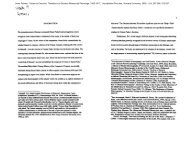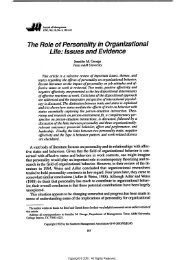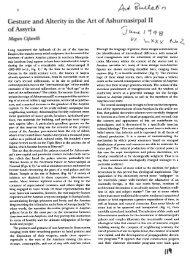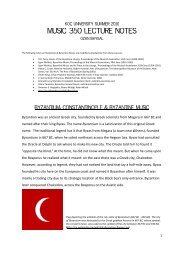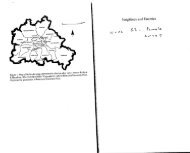The Hattian and Hittite Civilizations
The Hattian and Hittite Civilizations
The Hattian and Hittite Civilizations
Create successful ePaper yourself
Turn your PDF publications into a flip-book with our unique Google optimized e-Paper software.
Reliefofthe GoddessKubabaat Carchemish.Basalt.Height:95cm.Late<strong>Hittite</strong>Period.<br />
850- 750BC.Museum ofAnatolian<strong>Civilizations</strong>,Ankara.<br />
TraditionaI Style II. Kubaba sits in a ehair whicIı rests ırpon the baek of a lion. In one of<br />
her h<strong>and</strong>s she holds a pomegranate, symboI of fertiIity. In the other h<strong>and</strong> is a mirror.<br />
<strong>The</strong> mirror is deseribed as "the symboI of women" in <strong>Hittite</strong> written sourees.<br />
218<br />
Anatolicum = Melanges Laroche, Paris 1979, pp. 1 - 28). A number of factors reveal that the<br />
artistic creations of this center belong to the years between 727 - 700 BC: the hairstyles of<br />
the human figures, the iconographic details of the lion figures, two Phrygian vessels <strong>and</strong> a<br />
bronze bowl found together (E. Akurgal, Hatti ve Hitit Uygarlıklan, Fig. 129- 131) <strong>and</strong> especially<br />
the fact that the Bit Hilani of Teli Halaf closely resembles those of the early 7th century<br />
at Zincirli <strong>and</strong> Assur.<br />
Beginning with Kilamuwas (832 - 810 BC) the Aramaean kings of Zincirli show a<br />
dillerent headdress <strong>and</strong> stylization of hair <strong>and</strong> beard (Fig. 118, 119). it is also understood that<br />
the vertical diagonal folds of their garments are an Aramaean characteristic (Akurgal. <strong>The</strong><br />
Birth ofCreekArt, pp. 53 - 66). We have seen above that at Zincirli (Fig. 149) <strong>and</strong> Sakçegozü<br />
(Fig. 143, 148) works of superior quality come into being in the reign of King Barrekub<br />
(around 730 BC). This art consisted of <strong>Hittite</strong>, Assyrian <strong>and</strong> Aramaean elements <strong>and</strong><br />
achieved new dimensions thanks to the prosperity brought by the AramaeM kings.<br />
Semitic group s came from the south <strong>and</strong> exp<strong>and</strong>ed to northern Mesopotamia; as a<br />
result, Phoenician as well as Aramaean characteristics began to be dominant in <strong>Hittite</strong> art<br />
<strong>The</strong> products of a rich middle class that developed at Ivriz <strong>and</strong> Maraş in this period (end of<br />
the 8th, beginning of the 7th century BC) are worthy of mentian in any history of art<br />
(Akurgal, <strong>The</strong> Birth of Creek Art, Pı' 26 - 29). That writing was alsa used in these reliefs is<br />
an indication of the high st<strong>and</strong>ard of culture in that period. <strong>The</strong>se creations inf1uenced<br />
Hellene art in many aspects, as we shall see belaw.<br />
One of the earliest works that came to light from the excavations at Zincirli is now on<br />
display in the Berlin Museum. it depicts the Aramaean King Kilamuwas with anather person<br />
who is probably his son (Fig. 118, 119). We learn that the relief belongs to this king from the<br />
inscription on anather stele found in the same place (see: Luschan, AlS 375, Fig. 273;<br />
Akurgal, <strong>The</strong> Birth of Creek Art, PI. 54, Fig. 10). <strong>The</strong> large diagonal chignon on the nape of<br />
the neck of both figures is stylized according to the Assyrian fashion <strong>and</strong> reveals that the<br />
stele belongs at the earliest to the reign of Assur-nasır-pal il (883 - 859 Be). For the present<br />
this relief is the earliest depiction at Zincirli of an Aramaean king. <strong>The</strong> cap on Kilamuwas'<br />
head does not exist in Assyrian or <strong>Hittite</strong> art; it is Aramaean headgear. Though the hair <strong>and</strong><br />
beard are styHzed in Assyrian fashion, Kilamuwas does not have a mustache, in accordance<br />
with <strong>Hittite</strong> custom. In contrast, the noses of both figures are not of the shape of those seen<br />
in the <strong>Hittite</strong> style; theyare of the curved type that we see in Semitic populations. <strong>The</strong> king<br />
holds in his left h<strong>and</strong>, <strong>and</strong> his son in his right, the symbol of sovereignty in the form of a lotus<br />
bud.<br />
In anather relief from Zincirli King Barrekub is depicted (Fig. 138). This orthostat is<br />
also in the Berlin Museum; its inscription in Aramaic reads: "I am Barrekub, son of Panamu,<br />
219



